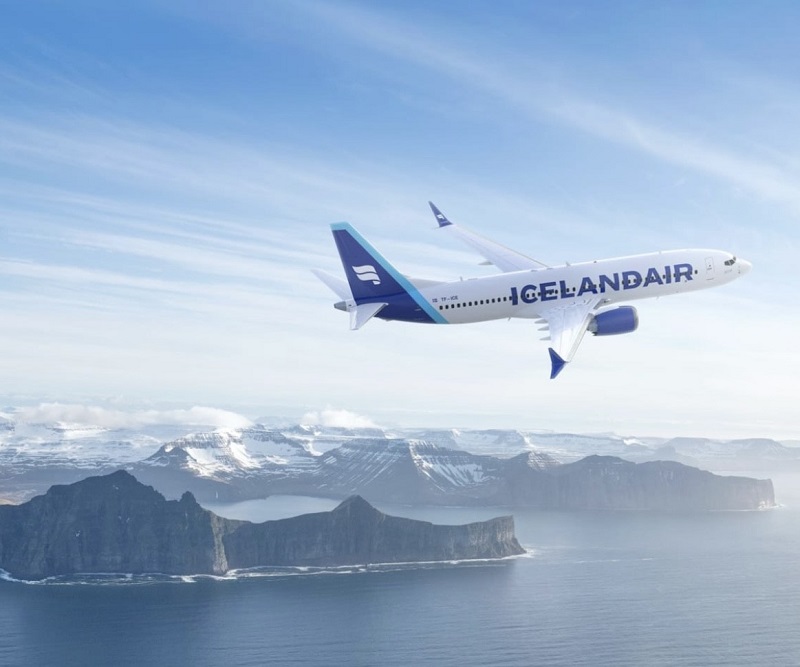 Icelandair
Icelandair 
Icelandair started operations in 1937 and has flown various aircraft over its long history. “We’re slow but we’re low” was the slogan as the airline started ferrying 20-something passengers to Luxembourg on DC-8s, with an obligatory stop in Iceland. Today, Icelandair is the flag carrier airline of Iceland, headquartered at Keflavík International Airport (KEF) near the capital city of Reykjavik. Iceland’s unique geographical position provides Icelandair with significant strategic advantages, making Iceland the perfect connecting hub between Europe and North America. Icelandair serves four markets: to, from, via and within Iceland. The aircraft departs to Europe early in the morning and returns to Iceland in the afternoon. They depart for North America late afternoon, arriving there early evening, and returning to Iceland at dawn the next day, just in time to depart again for Europe.
The Icelandair brand is one of the most widely recognised Icelandic brands, representing the airline's character, services and products.
Icelandair has Year-round destinations and Seasonal destinations:
Year-round destinations: Copenhagen, Stockholm, Oslo, Helsinki, Amsterdam, Paris, Berlin, Frankfurt, Munich, Zurich, London, Glasgow, Manchester, Dublin, Boston, New York, Seattle, Washington, Denver, Chicago, Toronto, Tenerife, Nuuk and Kulusuk.
Seasonal destinations: Rome, Nice, Montreal, Alicante, Raleigh-Durham, Bergen, Billund, Hamburg, Geneva, Brussels, Minneapolis, Vancouver, Portland, Anchorage, Baltimore, Milan, Madrid, Salzburg, Orlando, Ilulissat and Narsarsuaq.
Icelandair has a flexible Boeing fleet that marries commonalities with varying sizes and capabilities. The mix of aircraft is perfectly suited to serve Icelandair’s international route network, which is designed around the unique geographical location of Iceland as a connecting hub between Europe and North America.
Icelandair’s 2025 fleet is a blend of innovation and reliability, designed to get you where travellers need to go with comfort and efficiency. With 46 aircraft in total, the fleet is still dominated by Boeing, and here's what passengers can expect when they board:
Boeing 757s: The backbone of Icelandair’s long-haul operations, the 11 Boeing 757-200s and 2 Boeing 757-300s are perfect for flights to the US West Coast and Canada. Known for their range and versatility, these planes are built to take passengers on smooth and efficient journeys across the Atlantic.
Boeing 767s: When flying to Europe or the US East Coast, travellers will find the Boeing 767s offering a spacious cabin and excellent cargo capacity, ideal for high-density markets.
Boeing 737 MAX: The latest addition to the Icelandair fleet, the Boeing 737 MAX 8 and 737 MAX 9 are a modern marvel. With reduced fuel consumption, quieter engines, and an innovative cabin redesign, these aircraft bring a new level of comfort and eco-friendly travel.
Dash 8s: For short regional flights, especially in and around Iceland’s stunning landscapes, the Dash 8s are the perfect fit. Icelandair operates 5 Dash 8- 200s and 2 Dash 8- 400s (leased), providing efficient service on regional routes.
Airbus A321neo: For those travelling on shorter international routes, Icelandair also boasts 1 Airbus A321neo in the fleet, with 3 more on the way. Expect a modern, comfortable cabin with advanced technology.
Whether passengers jet off to a bustling city or embark on an unforgettable adventure, Icelandair’s diverse fleet ensures they will enjoy a comfortable, eco-conscious, and efficient journey.
Icelandair offers three booking classes: Economy Light, Economy, and Saga Class. Free meals are only available in Saga Class, and a buy-on-board service is provided for the Economy classes.
Icelandair has received the 3-Star Airline rating from SKYTRAX for the quality of its airport and onboard product and staff service. Product rating includes seats, amenities, food & beverages, IFE, cleanliness, etc, and service rating is for both cabin staff and ground staff.